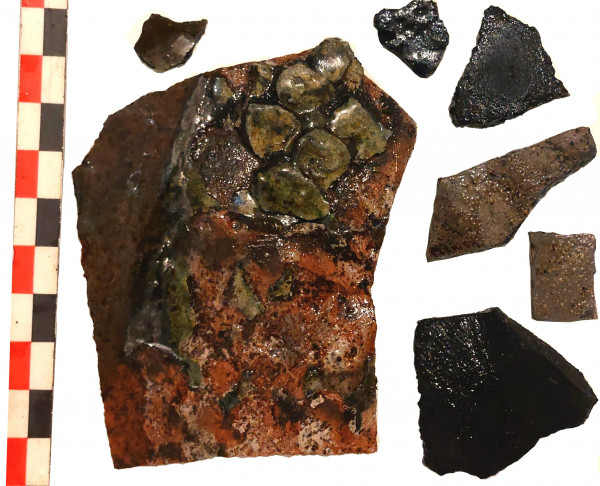








During the archaeological research, in the basement of the future home of the Museum of Music and Writing, at Mārstaļu iela 6, well-preserved evidence of the beginnings of Riga – XII–XIV centuries was discovered, that is, a completely intact archaeological cultural level with eight different layers was found at a depth of almost two metres, informs Jeļena Gavrilova, Member of the Board of the SJSC “State Real Estate”.
“This is a rather unique discovery found in the oldest part of Old Riga – near the former Riga lake (an extension of the River Rīdziņa). In the deeper layers, we saw a scene that was also found elsewhere in Old Riga, that is, in the first centuries of the city, this area was regularly flooded, and the ground level rose rapidly by one metre within a century. At the same time, we came across several interesting items and completely intact evidence of very early settlement in this area,” says archaeologist, Dr hist. Artūrs Tomsons.
There were not many finds that could be dated, but the most significant for understanding the chronology of the eras is a fragment of a luxuriously adorned ceramic vessel with a scale motif, which originated in the XII century in the territory of the present-day Netherlands and which continued to also be made in the XIII century – in the territory of present-day Denmark. They were found in the first layers, which means that the deeper metres of the archaeological cultural level were formed before that.
In the deeper layers, among the remains of a vertically driven pole and constructions made of boards, an entire working tool was found – a three-ribbed fork with a fully preserved wooden layer, as well as several processed wooden objects – presumably fragments of a beekeeping tool - a device for climbing a bee tree. These items were transferred to the Museum of the History of Riga and Navigation. At the deepest level, archaeologists came across the remains of a wooden wicker fence, similar to those known from excavations in nearby Albert Square. Most likely, a part of the settlement of the first inhabitants of Riga was discovered during the research.
On the other hand, in the upper layers, fragments of wooden vessels, leather shoes, fishing net floats, individual fragments of decorated wheel-made pottery and stoneware pottery were found. In this case, the wet environment “preserved” items made of organic materials that would not have remained under other conditions.
The intact inclusion of the cultural level between the foundation walls of the building was discovered in May 2022, after the removal of construction debris, by conducting a 1.5-metre deep probe in the room where the construction of the lift shaft was planned. Therefore, additional archaeological research was conducted there, which ended in August of this year.
“The interesting archaeological finds are another page in the very rich 400-year history of the three-storey building, which will also add an additional dimension to the future exposition of the Museum of Music and Writing. In other words, here in one place you will be able to feel the creation of Riga since the very beginnings of the city. We treat the history of the building with due respect and look for solutions to integrate the historical heritage into the design of new premises as much as possible,” says Jeļena Gavrilova, Member of the Board of SJSC “State Real Estate”.
Currently, strengthening of building constructions, construction of engineering networks and roof, painting of the facade, and renovation of windows take place in the building at Mārstaļu iela 6. During the previous dismantling works, the building has been freed from worthless layers and redundant partitions built in recent decades. For example, in the basement, the historical brick vault has been freed from the old layering, which visitors to the building will be able to see. Whereas, the attic, which has not been used for a long time, will be transformed into an event space with exposed historical structures.
The next phase of the work includes the restoration of the paintings of the interior walls and the entrance portal, so that the facade of the house regains its original splendour and becomes one of the pearls of the neighbourhood. The composition of the main facade of the building has been preserved since 1823. The facade has three window axes, it is still orientated towards the main street according to the system of creating city blocks in the Middle Ages, but the main volume of the building is hidden inside the block. The main accent is the luxurious portal made with rococo details – XVIII century art monument of state significance, located in the central part of the main facade of the building. Also, the structure of the 1st floor of the main facade, which was rebuilt in 1905 according to the project of the prominent Riga architect Wilhelm Bockslaff, has been preserved to this day.
It is expected that in the second half of 2023 the RMM’s permanent exhibits will move into the 1400 sq. m. wide premises of the Mārstaļu building; there will be exhibitions and a courtyard equipped for creative events. AS UPB has been working on the renovation of the historical building using the design by ‘Arhitektu birojs Krasts’ since summer 2021.
Photos from the archaeological excavations: https://faili.vni.lv/index.php/s/IndRZNl0CDDgXfZ
Photographs by: Artūrs Tomsons.

